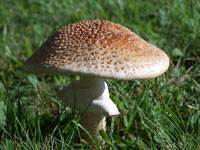A single Portabella mushroom can contain more potassium than a banana. Mushrooms are made up of around 90% water. The mushroom is used in many cuisines throughout the world and it is known as the "meat" of the vegetable world. Most mushrooms grown for human consumption today are done so in controlled, sterilized environments. The most popular type representing 90% of mushrooms consumed in the US is the White button mushroom. The brown version of Agaricus bisporus called the Crimini, and its mature version, Portobello, are both popular eatable mushrooms too. The worlds largest producer of edible mushrooms is China which produces about half of all cultivated mushrooms. Mycophagist is the term used for people who collect mushrooms to eat from the wild. The act of collecting these mushrooms is known as 'mushroom hunting', or 'mushrooming'. There are a few mushroom varieties found in the wild that are highly poisonous. A number of these look like common edible species, therefore it can be risky collecting wild mushrooms without good knowledge for identifying mushrooms. There are over 30 species of mushroom that actually glow in the dark. The chemical reaction called bioluminescence produces a glowing light known as foxfire. People have been known to use these fungi to light their way through the woods. In the Blue Mountains of Oregon is a colony of Armillaria solidipes that is believed to be the world’s largest known organism. The fungus is over 2,400 years old and covers an estimated 2,200 acres (8.9 km2). Above ground the honey mushrooms are short-lived but the underlying mycelium (branch like vegetation) lives on. Before the invention of synthetic dyes, mushrooms were widely used for dyeing wool and other natural fibers. Mushroom dyes are organic compounds and produce strong, vivid colors.
| | | 

| | More Food Facts: | | | | | | | | | | | | | | | | | Mushroom Facts | | | | | | | | | | | |
|